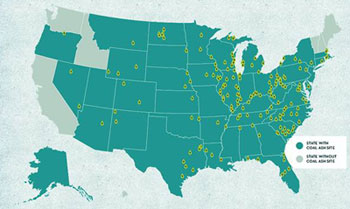After the devastating coal ash spill in North Carolina’s Dan River this year – exposing the total lack of regulation of waste from coal-fired power plants – the EPA has announced the first federal rules to correct that – but they don’t go far enough to make a difference.
In a 60 Minutes segment a couple of weeks ago, they illustrated the problem. Without regulations all these years, Duke Energy shuttered coal plants and left – leaving mounds of coal ash behind. The spill occurred from a pipe they were warned about for decades, but instead of replacing it, they merely watched it. Even now, they are considering using the cheapest option to close them – capping the impoundments where they are and insisting more research will show if they must also be lined at the bottom!
The Dan River coal ash spill followed the worst in history, when a billion gallons of sludge coated Kingston, Tennessee in 2008. By 2010, EPA was ready to issue regulations, but postponed them because of intense pressure from Republicans, utilities and the coal industry.
As usual, they warned regulations would be too expensive, costing jobs and raising electric rates. Even with the most stringent regulations and costs completely passed to ratepayers, electricity prices wouldn’t rise more than 1%, says EPA.
Coal ash dumps in the US:

As is too often the case, the EPA only issued regulations after being taken to court. "We had to go to court to force EPA to issue this first-ever coal ash rule, and unfortunately, we will be back in court to force coal plants to clean up their ash dumps and start disposing of their toxic waste safely," says Evans.
EPA requires:
- All new coal ash dumps must be lined and sited away from wetlands, waterways and other sensitive areas;
- Existing dumps must be closed if they don’t meet engineering standards;
- Regular inspections will be required
- Power plant operators must keep and post records on a public website that show annual groundwater monitoring results, corrective action reports, coal ash fugitive dust control plans, and dumps that have been closed.
Almost 40% of the coal ash generated in 2012 was sold for recycling, says EPA.
Vague, Minimal, Unenforceable
Criticisms from environmental groups:
- Amazingly, EPA doesn’t categorize coal ash as hazardous, waste, which requires much more expensive disposal practices than solid waste – because Republicans blocked EPA from doing that;
- EPA will still rely on the industry to police itself;
- The rules omit dumps at coal plants that have been closed!
"While EPA’s coal ash rule takes some long overdue steps to establish minimum national groundwater monitoring and cleanup standards, it relies too heavily on the industry to police itself, " notes Eric Schaeffer, Executive Director of Environmental Integrity Project.
"The power industry has had half a century or more to clean up its act, but even in the face of huge spills and a terrible record of proven water contamination around the country, it is still dumping ash in huge unlined pits," says Lisa Evans, an attorney for Earthjustice. "These dumps aren’t going away by themselves, and unfortunately under today’s rule, EPA is putting the burden on citizens to get them safely closed."
If they haven’t reported or remedied problems without oversight until now, why would that change?
This is serious business because coal ash contains some of the deadliest toxins, such as arsenic, lead, mercury, and hexavalent chromium, – linked to the four leading causes of death in the US, heart disease, cancer, respiratory diseases and stroke. It is the second largest industrial waste stream in the US.
140 million tons of ash is produced every year by US coal plants. There are 1,400 coal ash dumps, contaminating over 200 rivers, lakes and groundwater in 37 states.
"EPA’s coal ash rule is too little and too late. Too little because its standards are minimal, vague, and unenforceable. Too late, because damage from collapsing dikes and leaking ash dumps has accumulated in the absence of common sense rules designed to prevent those disasters," says Schaeffer.
In 2012, Earthjustice sued EPA on behalf of public interest groups and an Indian tribe to get a court-ordered deadline: Moapa Band of Paiutes, Nevada; Appalachian Voices, North Carolina; Chesapeake Climate Action Network, Maryland; Environmental Integrity Project, DC; Kentuckians For The Commonwealth; Montana Environmental Information Center; Physicians for Social Responsibility; Prairie Rivers Network, Illinois; Sierra Club; Southern Alliance for Clean Energy (8 southeast states); and Western North Carolina Alliance.
EPA met the December 19, 2014 deadline to the day.
Watch the 60 Minutes segment on Duke Energy:

We have the technology to help clean up these coal ash ponds! I am tired of being ignored. No matter what EPA decided Duke still has to clean up somehow. We want to help them. See rcbcglobalinc.com fascebook & twitter RCBC Global Inc.